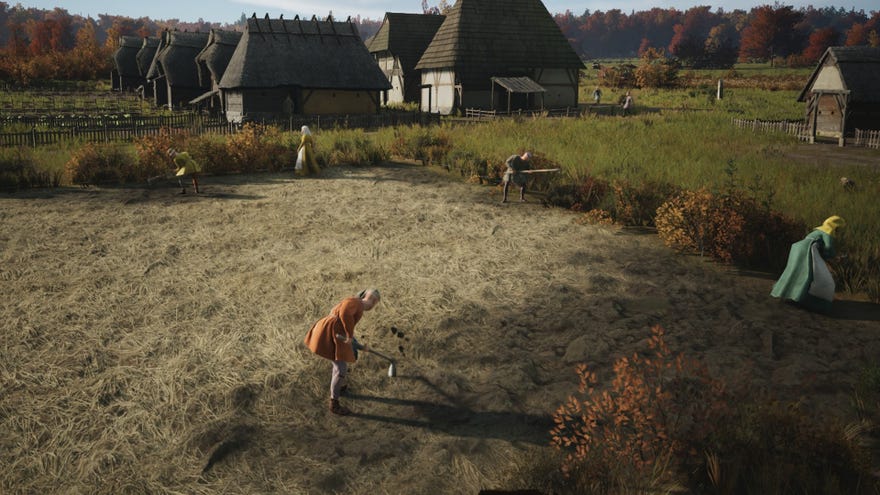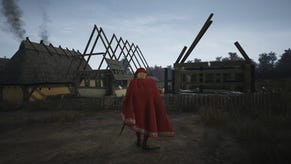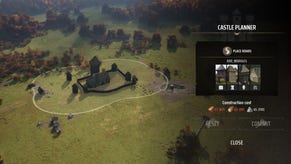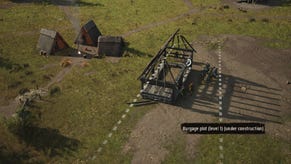Farming explained in Manor Lords
How to farm rye, wheat, and other crops in Manor Lords
Trying to figure out how farming works in Manor Lords? Setting up a farm is one of the major steps you'll need to undertake in Manor Lords to make your fledgling settler's camp transform into a bustling, healthy town. But there's quite a bit to figure out along the way, from basics like setting up your land plots to more involved questions like how farming works in tandem with the seasons.
We've spent enough time fiddling in the fields to give you some assistance. In this guide on how to farm in Manor Lords, we'll outline what you need to do to ensure that your farm is healthy and bountiful.
Farming explained in Manor Lords
To get started farming, you'll first need to construct a field. Like the Marketplace, the field is a flexible plot of land that you can chart by snapping four points on the map. While it's tempting to make a giant farm space all at once and call it a day, we recommend that you start small, building additional plots of land when you're comfortable with the basics of farming. Farms are measured in Morgens (a unit of land measurement equivalent to about two acres), and ideally your first farm will be around 1.0-1.5 Morgens.
You'll want to consider the fertility of the land when building your farm. You can get a sense of this by the heatmap that appears when you construct a farm, showing you which areas are best for which crops. Green areas are obviously better, and you'll want to pay most attention to the best regions for planting Barley, Rye, and Emmer (AKA Wheat).

Once you've made your plot, you can choose the crop you want your peasants to plant. Your choices include the following:
- Wheat (Can be turned into Flour, which can then be turned into Bread.)
- Barley (Can be turned into Malt, which can then be turned into Ale.)
- Flax (Can be turned into Linen, which can then be turned into Clothes.)
- Rye (Locked behind the Rye Cultivation Developmental Upgrade. Like Wheat, Rye can be turned into Flour, but is more resilient and can be grown in places with lower fertility.)
- Fallow (This means that you aren't actually growing anything, but your field's fertility level is regenerating.)
Once you've made your choice, construct a Farmhouse next to your plot of land for workers to till your fields. You can put up to eight families in a Farmhouse, so if you want your farm to grow fast, it's best to stock up on workers.
Once your peasants are tilling away, you can pay close attention to the progress of your crops by clicking on your plot and viewing the available data. You'll be able to see how many days you have until your crop yield, as well as a number of progress bars indicating plowing progress, sowing progress, crop growth, and harvest progress. You can also select different crops to rotate on a three-year basis.
Out of all of these bits of info, I've found it most useful to keep an eye on fertilization percentage. Higher percentages mean that the crop is growing faster, while lower percentages mean that growth is slow. If the percentage ever reaches zero, your plot of land is no longer fertile, and you'll have to switch whatever you're growing on it to Fallow.
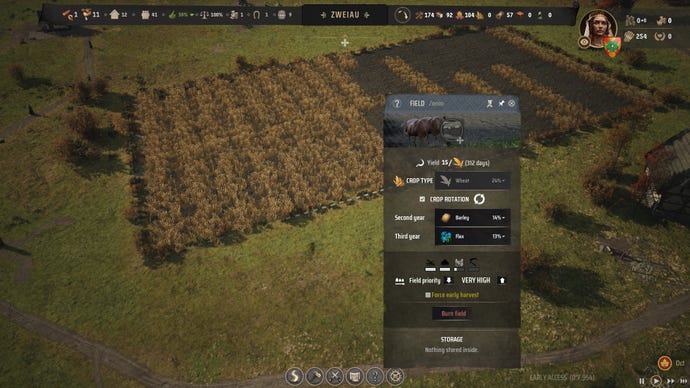
And those are the basics of farming! You can augment the output of your plot of land with structures like the Windmill, which is needed to turn Wheat and Rye into Flour, and the Communal Oven, which turns Flour into Bread. Pastures are required for letting sheep graze on your farm, while Sheep Farms allow you to gather Wool from those sheep.
Here are a few other general tips on farming to keep in mind as you begin your mission to grow crops:
- Farming can be a taxing experience in the early game that will preoccupy too many of your workers. Foraging and hunting wild animals are fine ways to keep your settlement running for the first year. As both resources are finite, it's a good idea to transition into farming by year two to give yourself a steady supply of crops and harvests.
- Harvesting, plowing, and sowing occur during the Autumn months, from September to November. Growing takes the longest, and usually goes on during the Summer months, from June to August. If all goes well, your crops will be ready well before the potentially harsh onset of Winter, but if they're not completely grown by then, they'll be harvested the following year.
- If you want your fields to be plowed faster, the Heavy Plow upgrade lets you use Oxen at your farmhouse. We have a whole guide on how to obtain more Oxen if you're short on these friendly bovines.
- On that note, if you'd like to make unfertile land plots quickly regain fertility, take the Fertilization Developmental Upgrade, which allows you to convert a Fallow field into a Pasture for sheep to graze on. Thanks to the grass-eating and defecation efforts of said sheep, your plot of land will gain its fertility back in no time.
That should be all you need to know on farming in Manor Lords. If you're on the lookout for more tips on upgraging your settlement, head on over to our guides on laying down roads, demolishing buildings, engaging in trade, or even exploring your ever-growing town in third person Visit Mode. We've also got a handy guide of Manor Lords tips and tricks if you're just getting started with the game.
